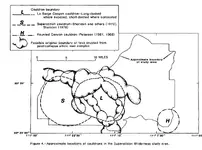I am no expert, but I can't think of any gaseous species of acidified gold, silver, lead, copper .... Can you be more specific about this chemistry? You do realize that gas chromatographs analyze gases, right? No one is trying to fight you. What it is is, you bring up stuff that seems unreal. So I ask. Then the bawking. I do not see where anything you have proffered about this shows any sort of exclusivity. Let us talk geologic events then. You go first. Timing, limitations, what is your specific claim here? Not that we put the other issue to rest.
Okay. I will give you the benefit of the doubt that you just want to understand and not just pick a fight.
Like I said, Thomas Glover went into pretty good detail in his book on the LDM. ANY mineral/metal can be dissolved into solution. Just a question of which acid to use (for instance gold can be dissolved into Cyanide). Here is a link where you can read about Trace Metal Analysis with Gas Chromatography:
GC TRACE METAL
To your final question; I have to again refer to Thomas Glovers LDM Book. I don't have it with me right now, but the testing method they used was actually EDS (Energy Dispersive XRay Spectroscopy). An SEM or TEM (Transmission Electron Microscope) is used in that method of testing, but it is only a part. Lets say the Match Safe is from an Epithermal Quartz Deposit. One rumor is that Waltz highgraded his ore when he was working at the Vulture Mine. We have Joseph Porterie that said this ore is unlike anything ever found at the Vulture, and also that there is zero documented evidence that Waltz ever worked there. Lets say that you require more than Porterie's Word that the Match Safe Ore could not have come from the Vulture. Go to the old Vulture Mine (or the Bluebird) and get a sample of Vulture Pay Streak Ore. That ore is tested and shows it is Mesothermal in nature. Because of that, we can EXCLUDE with 100% certainty the Vulture Mine as being the source of the Match Safe Ore. The testing that is currently possible can exclude or include various sources of ore as possible matches.
Now, some things we have to arrive at answers by various methods: Where did the Match Safe come from? Not just Dick Holmes, but a few people got some of the ore from Waltz' Candlebox. Several people had jewelry made from that ore. Cuff Links, Two Rings, Tie Tack, Lady's Bracelet (which may have been altered to be a watch chain), are some of the known ore sample jewelry. If we could get all that jewelry together and do EDS Testing on it, we can tell if it was from the same geologic event. We can put to rest the theory that Waltz Candlebox Ore was an accumulation of many years of prospecting and mining if all the ore was from the same geologic event. By geologic event, I mean that there are three Volcanic Caldera's in the Supers. Two of them overlap, and one is by itself in the Southeastern end of the mountains. Each Caldera has its own fingerprint. In each caldera, the minerals formed differently from the others. Between the three calderas, they covered the Supers in a 40-70 foot layer of volcanic tuff. Here is a caldera map that someone else posted (I apologize for not remembering whom it was):

If all the jewelry matched the EDS Samples of ONE Caldera, we can ASSUME (although I hate to do that) that all the ore samples are from the same mine (source). Using the science we have today, we can eliminate a BUNCH of the theories that have been circulating for many years................... and the more we can eliminate, the closer we get to the actual source.
I can't put it any plainer than that.
Mike








